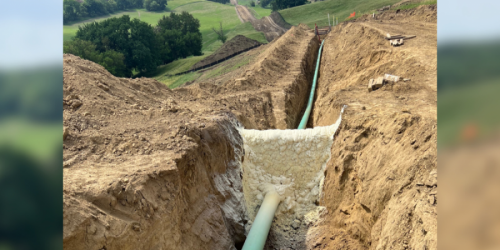Q&A Forums
spraying underside of corrugated steel roof deck Post New Topic | Post Reply
| Author | Comments |
|---|---|
|
Steve Richards
Posted: Apr 14, 2010 01:46 AM
|
spraying underside of corrugated steel roof deck
Has anyone had success with spraying open cell on the underside of corrugated steel? I've done it with CC, never with OC. How is the adhesion? Yes, there is insulation on top of the roof as well, so condensation shouldn't be an issue here. My goal is cost savings and perhaps the ability to be more aware of roof leaks in the future. Closed cell may cause a double vapor barrier issue and the customer has voiced concerns relating to roof leaks.
|
|
Ivan Pauliuchenka
Posted: Apr 14, 2010 06:26 AM
|
I did spray 6.000 sq ft place in Truro MA with same situation as you have: Flat metal roof with R20 on top of the roof and I sprayed 6" of BioBased 501w on the underside . No problems with adhesion to the substrate. |
|
Gerry Wagoner
Posted: Apr 14, 2010 09:00 AM
|
There should be no problem with open cell on the underside of metal decking as long as the surface is clean & dry. I actually prefer open cell foam for this application because the extra material covers the corrugations better/easier. Depending on your climate zone, use enough material to avoid condensation issues (open-cell) posesses no vapor barrier qualities. have fun, oG |
|
Steve Richards
Posted: Apr 14, 2010 01:18 PM
|
Thanks Guys, I will give it a shot then. I appreciate the info. Steve |
|
Posted: Apr 15, 2010 04:25 AM
|
reflections from the cornfield,,, double vapor barrier??? yes a sufficient application of cc foam will provide a vapor retarding membrane,,,,no matter which direction the vapor diffusion,,, that being said,,, a vapor retarding membrane will not prevent or stop gross water migration,,,lets say from a leaking roof...even if the cc foam covers the trusses it will manifest it self somewhere,,usually further down the roof at the heels in the above mentioned configuration... if the foam is "within" the roof trusses the water will show on the truss frameing further up the assembly..water is a biatch,,you dont stop leaks from the underside of a roof,,, open cell foam in a lid-under application can "hold water" back as well,,the skin on the foam can hold back "gross" water allowing the sponge like material the ability to hold water,,and since you wont be trimming the foam in this type of application the skin will be left on the foam... |
|
Steve Richards
Posted: Apr 15, 2010 04:49 AM
|
I wasn't implying that a vapor barrier would hold against bulk water intrusion. I simply don't like to trap any building material between two impermeable (or relatively so) membranes, in this case, the closed cell foam on the underside and the various layers below the surface membrane of the roof. I also recognize that OC foam "skin" will provide resistance to bulk water flow, or at least moreso than the body of the foam itself, but it is my assumption that the OC would theoretically permit water flow to a greater degree than CC. I would guess that a roof leak would be likely to present itself on the sheetrock ceiling below that of the leak, in a closer proximity to the leak itself with an OC application, than would be the case with a 2"+ application of CC foam. I've dealt with this question a number of times in regards to residential, pitched roof applications, but until I see hard evidence of what actually occurs in the case of a roof leak in an unvented attic, either on thermal imaging, or by picking it apart, it's only theoretical. I would really love to have a great answer for the consumer question, "what if my roof leaks?", as this comes up often. Perhaps I'm wrong, but any advice is appreciated, as I'm always looking to further educate myself on such topics. On another note, and perhaps this is a question for another thread, but I've recently had 2 customer complaints about pervasive odor, months after application of OC foam in an unvented roof asembly. The odor seems to have become apparent with the advent of the recent warm weather and sunny days on the roof surface, due to a change in season. There was no complaint about the insulating properties, rather to the contrary, but the plastic smell has raised serious concerns. I will of course, contact the manufacturer, and of course the room was well ventilated with a 3200 cfm blower fan during application. Any ideas? The foam is LaPolla, which I've had great success with thus far. |
|
Posted: Apr 17, 2010 05:24 AM
|
hey man,, come on out to my shop,,, leaked when we sprayed it in 1998,,, 5"cc,,and it still leaks,,, and the water drips to the floor below the leaks,,now it appears to travel down the rafter in a couple of places,,, the answer to your customers whom say "what if the roof leaks" smile and say "then you got a leakin roof that needs to be repaired" and the "break/defect" in the pitched roof system is "usually" readily apparant not sure about the oder.... keep us advised |
|
terri burgess
Posted: Jul 21, 2010 09:07 AM
|
Hi Guys, i am spraying the underside of a wooden indoor swimming pool and the underside of a metal hockey arena. I used CC on the pool, and am think of using 2 inchs of CC on the arena with a Low E reflective ceiling.( do u think this will be sufficient?) I was also told i should use a Vapour Retarder Coating. I thought the CC had vapour retarding characteristics built in?? Do i need another vapour retarder? Thanks. |
|
terri burgess
Posted: Jul 21, 2010 09:07 PM
|
Sorry, that should have read 'spraying the underside of the roof (which is plywood) of an indoor pool' not a wooden pool. lol Any vapour barrier issues i should be worried about with just using the CC foam and no other Vapour Retarder? or should i use both? thnx |
|
Steve Richards
Posted: Jul 24, 2010 02:36 PM
|
depending on the manufacturer of cc foam you're using, it should serve as a vapor retarder in thicknesses over 1". A supplemental vapor barrier should not be necessary. |
|
Steve Richards
Posted: Jul 24, 2010 02:40 PM
|
As for the ceiling you mentioned, I am not familiar with Low Emissivity roofing systems, but this may be due to regional nomenclature. 2" should be an adequate vapor retarder, but depending on the climate, it may or may not be enough to avoid condensation issues. |
|
SprayFoamSupply.com
Posted: Jul 25, 2010 06:15 AM
|
Even though closed cell foam at 2" is a vapor retarder, when you have a constant 1 way vapor drive, there must be an additional vapor retarder on the warm side of the foam. This would be on the interior of your indoor pool building and on the exterior of your hockey arena. You can check out the SPFA technical document for design of cold storage buildings. It is the sixth one down http://www.sprayfoam.org/index.php?page_id=242 George |
|
Posted: Jul 27, 2010 07:56 PM
|
We always sprayed the top as a roofing system. When you insulate from the exterior you increase the efficiancy. It also serves dual purposes. |
|
Butyl EPDM
Posted: Aug 09, 2021 10:02 AM
|
On the corrugated steel roof deck, I would prefer to use a liquid sealant because spraying the underside might not be durable. Spread the sealant “Butyl Liquid Rubber” over the problem areas. If the patch application works for you then it’s enough.Otherwise a single application over the whole roof will eliminate the risk of future roof damages for more than a decade. It will seep into the metal layers and completely block the leakage points permanently. The premium feature of “Butyl Liquid Rubber” is that it is available in different colors while other sealants are only available in white or black, so you have a wide variety to choose from. |
|
sarah Nolyerr
Posted: Sep 29, 2023 11:59 PM
|
It is worth exploring the option of spraying open cell foam on the underside of corrugated steel but I recommend reaching out to a local roofing like HTML color codes MD Local Services, for expert advice and assistance. They can assess your specific situation, provide guidance on materials and techniques |
|
sarah Nolyerr
Posted: Sep 30, 2023 12:00 AM
|
It is worth exploring the option of spraying open cell foam on the underside of corrugated steel but I recommend reaching out to a local roofing like roof MD Local Services, for expert advice and assistance. They can assess your specific situation, provide guidance on materials and techniques |
|
Bawisher jaky
Posted: Jan 20, 2024 03:05 AM
|
My EPDM roof must have a big section cut out to repair water damage (a leak around ac that only showed up recently, must have leaked for some time). I am looking for suggestions as to what liquid roof product to use to do the entire roof over the existing rubber roof as well as the exposed plywood.. I’m leaning toward a system but would love to find what others have used with success. |





























